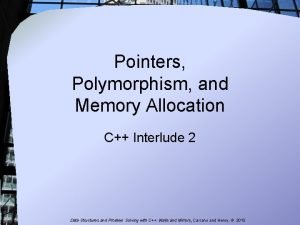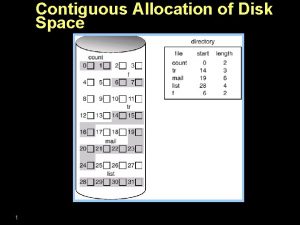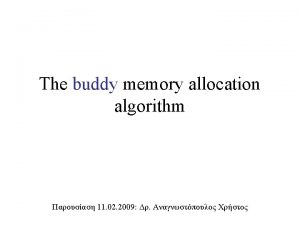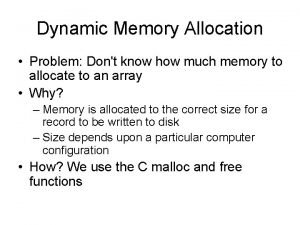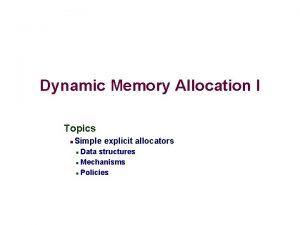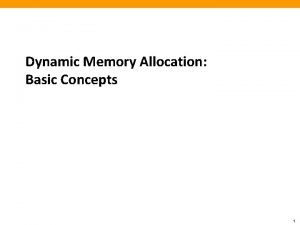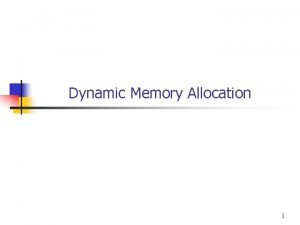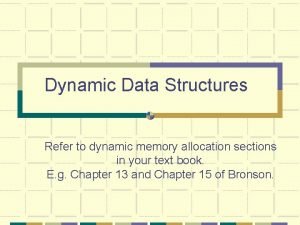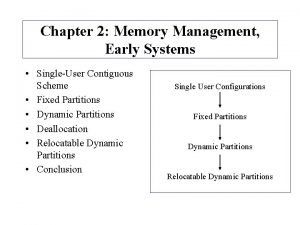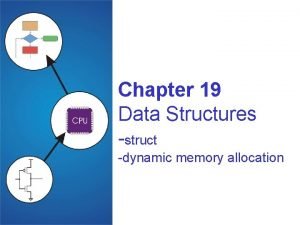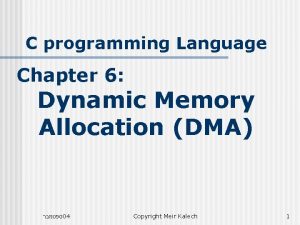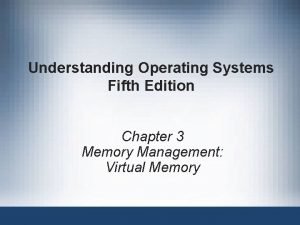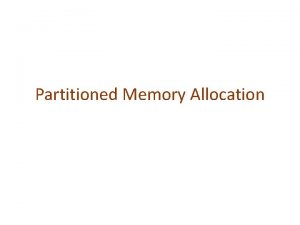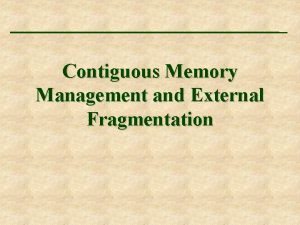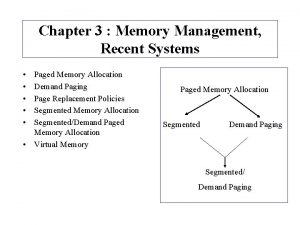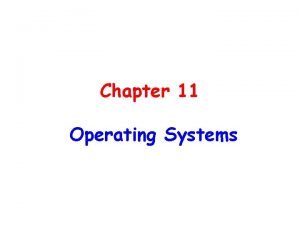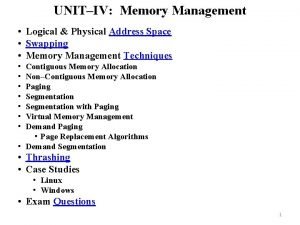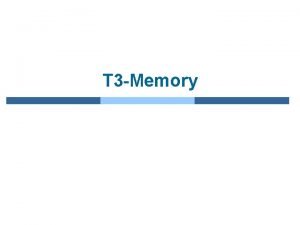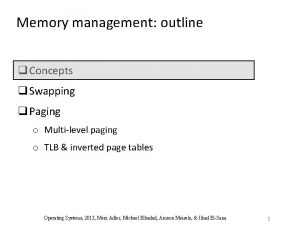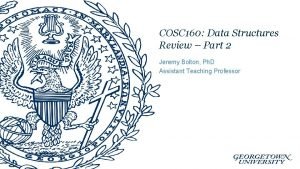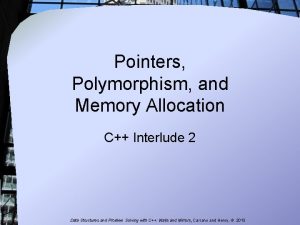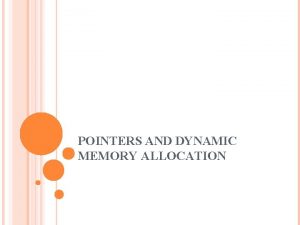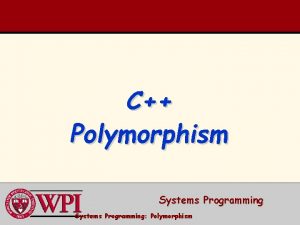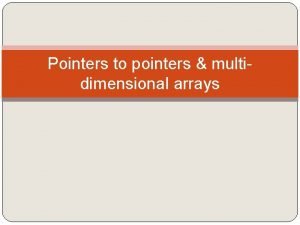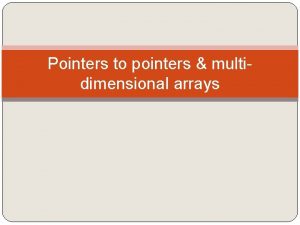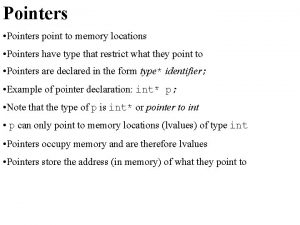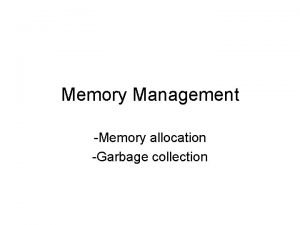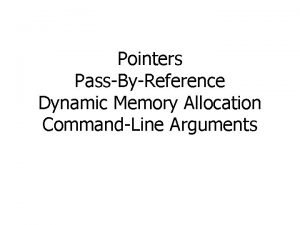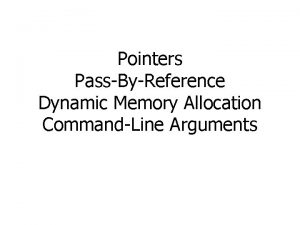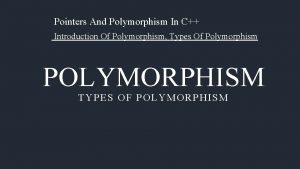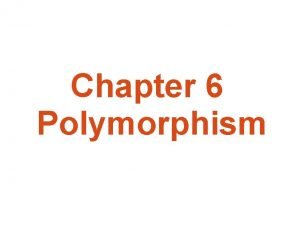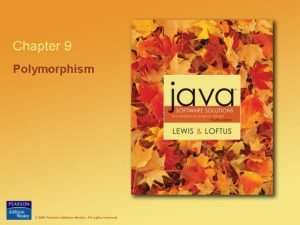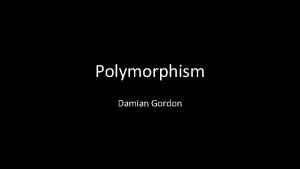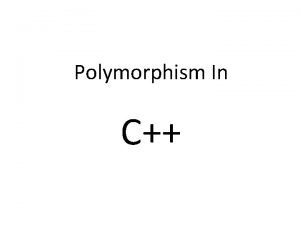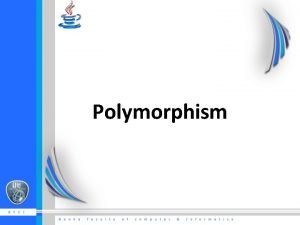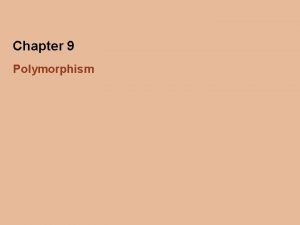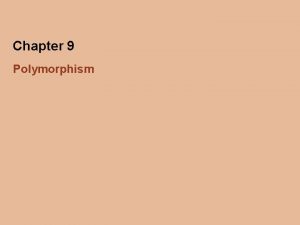Pointers Polymorphism and Memory Allocation C Interlude 2






















- Slides: 22

Pointers, Polymorphism, and Memory Allocation C++ Interlude 2 Data Structures and Problem Solving with C++: Walls and Mirrors, Carrano and Henry, © 2013

Contents • Memory Allocation for Variables and Early Binding of Methods • A Problem to Solve • Pointers and the Program’s Free Store • Virtual Methods and Polymorphism • Dynamic Allocation of Arrays Data Structures and Problem Solving with C++: Walls and Mirrors, Carrano and Henry, © 2013

Memory Allocation for Variables and Early Binding of Methods • A function’s locally declared variables placed into run-time stack • Storage for newly created object placed into activation record § Instantiated objects placed into run-time stack Data Structures and Problem Solving with C++: Walls and Mirrors, Carrano and Henry, © 2013

Memory Allocation for Variables and Early Binding of Methods • Early binding § Memory location set during compilation § Cannot be changed during execution • Sometimes early binding and automatic memory management insufficient § In context of polymorphism § Access of an object outside of the function or method that creates it. Data Structures and Problem Solving with C++: Walls and Mirrors, Carrano and Henry, © 2013

Memory Allocation for Variables and Early Binding of Methods From previous Interlude … • Creating a video game with a group of classes to represent three types of boxes § Plain box, Toy box, Magic box • Function with two arguments: § Object of any of the three types of boxes § An item of type string § Should place item in box with set. Item method. Data Structures and Problem Solving with C++: Walls and Mirrors, Carrano and Henry, © 2013

Memory Allocation for Variables and Early Binding of Methods FIGURE C 2 -1 UML class diagram for a family of classes Data Structures and Problem Solving with C++: Walls and Mirrors, Carrano and Henry, © 2013

Pointers and Program’s Free Store FIGURE C 2 -2 Sample program memory layout Data Structures and Problem Solving with C++: Walls and Mirrors, Carrano and Henry, © 2013

Pointers and Program’s Free Store FIGURE C 2 -3 Run-time stack and free store after mybox. Ptr points to a Magic. Box object and its data member item is set Data Structures and Problem Solving with C++: Walls and Mirrors, Carrano and Henry, © 2013

Pointers and Program’s Free Store FIGURE C 2 -4 my. Box. Ptr and the object to which it points Data Structures and Problem Solving with C++: Walls and Mirrors, Carrano and Henry, © 2013

Pointers and Program’s Free Store FIGURE C 2 -5 Two pointer variables that point to the same object Data Structures and Problem Solving with C++: Walls and Mirrors, Carrano and Henry, © 2013

Pointers and Program’s Free Store Other issues: • Deallocating Memory • Avoiding Memory Leaks • LISTING C 2 -1 Poorly written function that allocates memory in the free store Data Structures and Problem Solving with C++: Walls and Mirrors, Carrano and Henry, © 2013

Pointers and Program’s Free Store FIGURE C 2 -6 (a) Creating the first object; (b) creating the second object; Data Structures and Problem Solving with C++: Walls and Mirrors, Carrano and Henry, © 2013

Pointers and Program’s Free Store FIGURE C 2 -6 (c) assignment causes an inaccessible object Data Structures and Problem Solving with C++: Walls and Mirrors, Carrano and Henry, © 2013

Pointers and Program’s Free Store • View Listing C 2 -2 Header file for the class Good. Memory • Consider Listing C 2 -3 Implementation file for the class Good. Memory • Contrast my. Leaky. Function. htm code listing files must be in the same folder as the. ppt files for these links to work Data Structures and Problem Solving with C++: Walls and Mirrors, Carrano and Henry, © 2013

Avoiding Dangling Pointers FIGURE C 2 -7 Two pointers referencing (pointing to) the same object Data Structures and Problem Solving with C++: Walls and Mirrors, Carrano and Henry, © 2013

Avoiding Dangling Pointers FIGURE C 2 -8 Example of a dangling pointer Data Structures and Problem Solving with C++: Walls and Mirrors, Carrano and Henry, © 2013

Avoiding Dangling Pointers How to avoid dangling pointers • Set pointer variables to nullptr either initially or when you no longer need them • Test whether a pointer variable contains nullptr before using • Don’t delete object in free store until certain no other alias needs it • Set all aliases that reference a deleted object to nullptr when object is deleted Data Structures and Problem Solving with C++: Walls and Mirrors, Carrano and Henry, © 2013

Virtual Methods and Polymorphism • Consider Listing C 2 -4 Revised header file for the class Plain. Box Key points about virtual methods • A derived class can override • Must implement a class’s virtual methods • Derived class does not need to override existing implementation of inherited virtual method. Data Structures and Problem Solving with C++: Walls and Mirrors, Carrano and Henry, © 2013

Virtual Methods and Polymorphism Key points about virtual methods • Any of a class’s methods may be virtual. • Constructors cannot be virtual • Destructors can and should be virtual. If you do not want derived class to override a particular method, it should not be virtual • Virtual method’s return type cannot be overridden Data Structures and Problem Solving with C++: Walls and Mirrors, Carrano and Henry, © 2013

Dynamic Allocation of Arrays • Ordinary C++ array is statically allocated • Use new operator to allocate an array dynamically • delete returns dynamically allocated array to system for reuse • You can increase size of dynamically allocated array Data Structures and Problem Solving with C++: Walls and Mirrors, Carrano and Henry, © 2013

A Resizable Array-Based Bag Data Structures and Problem Solving with C++: Walls and Mirrors, Carrano and Henry, © 2013

End Chapter C++ Interlude 2 Data Structures and Problem Solving with C++: Walls and Mirrors, Carrano and Henry, © 2013
 Ingrid pollard pastoral interlude
Ingrid pollard pastoral interlude Polymorphism dynamic allocation
Polymorphism dynamic allocation Linked allocation
Linked allocation Disadvantages of dynamic memory allocation in c
Disadvantages of dynamic memory allocation in c Buddy memory allocation implementation
Buddy memory allocation implementation In which segment dynamic memory allocated
In which segment dynamic memory allocated Example of dynamic memory allocation
Example of dynamic memory allocation Explicit memory allocation
Explicit memory allocation Tcmalloc
Tcmalloc Example of dynamic memory allocation
Example of dynamic memory allocation Dynamic memory allocation in data structure
Dynamic memory allocation in data structure Single-user contiguous scheme
Single-user contiguous scheme Dynamic memory allocation in data structure
Dynamic memory allocation in data structure Dma dynamic memory allocation
Dma dynamic memory allocation Paged segmentation
Paged segmentation Memory allocation policy
Memory allocation policy External fragmentation
External fragmentation Segmented/demand paged memory allocation
Segmented/demand paged memory allocation What are two goals of multitasking memory allocation
What are two goals of multitasking memory allocation Contiguous memory management in os
Contiguous memory management in os Non contiguous memory allocation
Non contiguous memory allocation Jihad
Jihad Non contiguous memory allocation
Non contiguous memory allocation

